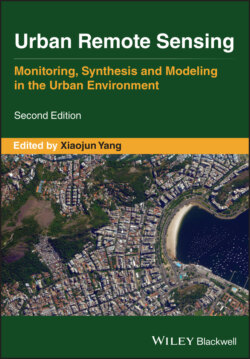Читать книгу Urban Remote Sensing - Группа авторов - Страница 23
1.3.4 URBAN ENVIRONMENTAL APPLICATIONS
ОглавлениеWith six major chapters, this part (Part V) showcases some latest progress in the integration of remote sensing and relevant geospatial techniques for urban environmental applications. It begins with Chapter 16 presenting the first man‐made CO2 emission map based on NASA’s Black Marble Nighttime Lights Product Suite (NBM). The authors compare the performance of NBM in estimating man‐made CO2 emissions with previous NTLs and population estimators and conclude that the estimation in the new NBM‐based CO2 map is likely closer to the truth. They also discuss the advantages and challenges in using NBM for mapping CO2 from urban areas.
The remaining chapters are related to such issues as urban microclimate, air pollution, urban standing waters, urban green infrastructure, and urban sustainability. Chapter 17 is concerned with thermal infrared remote sensing of urban microclimate. The authors develop a method to deal with the challenge caused by the urban geometry preventing a nadir‐looking radiometer to observe all urban facets, which makes the observed urban radiometric surface temperature (Tr) different from the urban complete surface temperature (Tc). Their method is based on numerical experiments with an urban microclimate model to help understand the thermal radiative transfer within the built‐up space and then the relationship between observed Tr and Tc. They further present a case study to demonstrate the methodology and discuss some issues for improving the applicability of thermal infrared remote sensing in urban areas. Chapter 18 targets remote sensing of air pollution in urban areas emphasizing the fundamental considerations in transforming satellite‐derived Aerosol Optical Depth (AOD) retrievals into Particulate Matter concentrations (PM) estimations at the ground level and by pixel. The author firstly discusses the complexity of air pollution monitoring from space and then proposes a comprehensive approach being built upon advanced technological development to examine different pollution sources and possible factors controlling their spatiotemporal variability. Chapter 19 focuses on remote sensing of urban after‐rain standing water bodies that can become mosquito larvae‐favorable environments and trigger disease transmission in high‐populated areas. The authors successfully develop a multilevel image analysis framework integrating multisource remote sensor data of weather and built environments from various spatial scales to detect urban standing water bodies. Such information can provide health authorities with reference guidelines to geographically prioritize the targets of mosquito larval control in urban areas. Chapter 20 provides a comprehensive review on the progress in remote sensing of urban green infrastructure. The authors firstly discuss the ecosystem services provided by urban green infrastructures, which include improvement of water and air quality, mitigation of the UHI, flood regulation, carbon sequestration and storage, and biodiversity conservation. They then provide an overview of how new advances in remote sensing can enhance urban green infrastructure knowledge and relevant planning. The last chapter (Chapter 21) discusses how remote sensing and EO can help quantify SDG indicators. The authors specifically consider UN SDG 11.7 (universal access to safe, inclusive, and accessible, green, and public spaces, etc). While aggregated green spaces can be effectively mapped and quantified by remote sensing, separating “public” versus “private” green spaces needs additional data. The authors take a close look at the relationship between urban green and urban climate as the latter can directly affect the quality of life. They survey the current remote sensing literature concerning UHI effects and cooling effects of green spaces and conclude that combining existing remote sensor data can support scientists in tackling current and future challenges.
